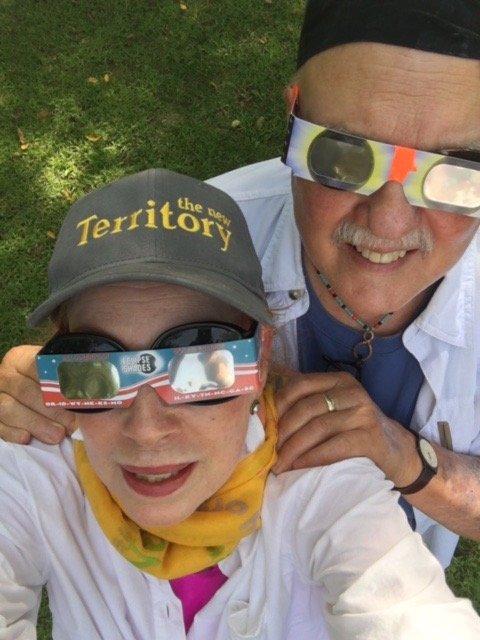Cosmic Events
A total solar eclipse occurs somewhere in the world every 18 months. Most occur in the middle of nowhere or somewhere over the vast expanse of water that covers 71 percent of the earth’s surface. Most often, they are witnessed only by inhabitants of sparsely populated remote locations and by a devoted cadre of umbraphiles (eclipse chasers) and scientists. But not always.
The August 2017 National Geographic “Space Issue” included a map of what NG called “the best eclipse in a century.” Traveling at 1,650 mph, that rare eclipse cut a diagonal path 70 miles wide across multiple cities in 12 states, including Missouri where we were living at the time. Stretching from Salem, Oregon, to Charleston South Carolina, it was the first total solar eclipse to cross the United States in ninety-nine years.
“On August 21, 2017,” the article explains, “the moon will cast a shadow that will take a little over an hour and a half to traverse North America, plunging some areas into darkness for as much as two minutes, 41 seconds.” For viewers in the darkest part of this shadow, the umbra, everything will be obscured except a brilliant ring of light and the starry expanse of the Milky Way.
Watch parties, cosmic-themed tours, and scientific observations were planned for what was called the Great American Solar Eclipse. Lawn chairs, Solumbra hats, SPF 30+ lotion, solar eclipse-approved glasses, food and libations were at the ready. Kit and I had been advised NEVER to look directly at the sun, except during totality, without proper eye protection. Caught up by the spirit of the moment, I created a box with a mirror inside that fit over my head and allowed me to look at the eclipse but not directly. For our watch party of two, we carried Adirondack chairs out to our open meadow—the perfect place for experiencing the cosmic event. Included in our snacks and libations were the perfect treat—Little Debbie’s Cosmic Brownies and Moon Pies.
At 11:45 AM (CST) the moon began to pass between the earth and the sun over Columbia, MO. The solar eclipse reached totality at 1:13 PM and there was total darkness for 2 minutes and 39 seconds. After 2 hours and 55 minutes, the sun was fully in view again at 2:40 PM. Across the country, people wondered what it would feel like when the moon, tilted at just the precise angle necessary, passing between the earth and sun. Grant Butler, a Portland columnist for The Oregonian chronicled comments by locals who witnessed the February 26, 1979 solar eclipse, visible in the early morning over the Pacific Northwest region of the U.S. and parts of Canada. Butler wrote:
“As the sky started to darken, a hush fell over the crowd. Everyone (was) overcome by what was happening. An unearthly moment (occurred) as the moon completely blocked the sun and the sky went black. The silence was complete: no birds sang or chirped; no words were spoken. A collective gasp of appreciation of the power of nature filtered through the crowd. It literally gave us goosebumps.”
Portlander Kathy Manville described hearing coyotes in mid-day. Gene Rushing of Hood River recalled the air temperature dropping dramatically while he was enveloped in the darkness. In Boring, Ore, Diana Mattox’s chickens headed back to roost when the sky turned dark, a phenomenon associated with solar eclipses. Our nephew Nathan Salter remembered that the snow in Rice Lake, Wisconsin appeared to turn silver as he walked to school after having his braces tightened.
For the August 21, 2017 cosmic event, The Atlantic republished American author Annie Dillard’s 1982 classic essay “Total Eclipse”—her personal experience while viewing the 1979 solar eclipse near Yakima, Washington. Dillard wrote—
“The sky snapped over the sun like a lens cover. The hatch of the brain slammed. The sky’s color was a deep indigo, a color never seen…. The sun was going and the world was wrong. The grasses…were platinum…as an art photographer’s platinum print….. The hues were metallic, their finish was matte…. I was standing in a movie of hillside grasses filmed in the Middle Ages. I missed my own century, the people I knew, and the real light of day.”
Tomorrow, on October 14, 2023, an annular solar eclipse will be visible as it crosses the sky from Oregon to Texas for the first time since 2012. Unlike a total solar eclipse, an annular eclipse means that the outer corona of the sun will be visible, producing a beautiful “Ring of Fire.” Starting in Oregon at 9:13 a.m. it will then move southeast across parts of CA, Nevada, AZ, CO and New Mexico to the Texas Gulf Coast.
To our west in Sacramento, the eclipse will be 80.31% visible starting at 8:05 am, max at 9:20 am, and end at 10:43. Hoping that is the case here in Nevada City and Grass Valley as well. Fortunately for my sisters Kim and Kelly, the western part of the Texas hill country and San Antonio where they reside will have 100% visibility. For them, tomorrow’s annular solar eclipse promises to be a cosmic event not to be missed. I’ll expect a full report when they visit Kit and me later this month.






